Introduction
The successful realization of any project depends on the development of an appropriate schedule and the allocation of resources. The focus of this project was on enhancing furniture manufacturing in the United Arab Emirates (Abu Dhabi) with reference to finding the best possible project management practices to ensure that the assignment is completed efficiently within the shortest time. The rationale for the project development was the fact that, according to the Dubai Chamber of Commerce, the Gulf region has become one of the most successful markets in the world of furniture production (“UAE’s GDP to grow 3.8% on average in next 5 years,” 2019). Having analyzed the most important tendencies related to business development in the UAE, it was found that there were many possible business alternatives.
Still, the decision to focus on furniture production in Abu Dhabi was the most appropriate one due to a wide range of development opportunities in case of success. Following the analysis of the present market situation, it was found that Abu Dhabi attracts a great number of tourists annually, and there is a focus on opening new hotels and redesigning hotel rooms to meet tourists’ expectations. Therefore, it was reasonable to concentrate on the production of hotel furniture.
A certain delay was observed in relation to finishing this project when 40% of the project development plan was complete. The project was started in March 2017, with the goal of opening the furniture production company in July 2017. This company planned to compete with European and American customers that provide furniture for hotels in the UAE in terms of offering furniture at a lower cost, developing an online-based business to allow customers to place orders at any time from any location, and attracting customers by providing for investment in the quality of furniture. The workshop would be located in Abu Dhabi, and the main product line would include every item necessary to furnish a house, an office, or an institution.
Project Description
The company has been established to help customers in Abu Dhabi avoid spending a lot of money on furniture produced by brands that usually sell products at higher prices due to significant advertising expenses. Unlike other manufacturers of furniture available in Abu Dhabi, the price of products depends on customers’ willingness to pay for the quality of the furniture instead of the brand name. The company sells products online, and this aspect explains the pricing strategy. The analysis of customer preferences makes it possible to provide them with a range of popular materials and styles they can choose from. The company’s products will meet the expectations mostly of smaller hotels in Abu Dhabi, as well as private clients.
The company produces furniture of different kinds to furnish halls, bedrooms, or living rooms. While using the website, it is possible to order single or double beds, armchairs, cushion chairs, and sofas. The company’s workshop is located in Abu Dhabi, providing local customers with the advantage of avoiding delivery expenses. In developing newer pieces of furniture, designers pay attention to choosing the best materials, which are convenient and safe. The company is ready to collaborate with local hotels interested in high-quality products on favorable terms.
Project Objectives
The following objectives have been formulated for this furniture manufacturing project:
- to manufacture a variety of furniture items (armchairs, beds, cushion chairs, sofas, etc.);
- to work in accordance with the style and material preferences of customers in Abu Dhabi;
- to establish an effective collaboration with many private customers and hotels located in Abu Dhabi;
- to provide customers with an opportunity to order pieces of furniture made with regard to their own designs, focusing on high quality and competitive prices;
- to become popular among customers in Abu Dhabi within a year;
- to use a wide range of materials, such as wood, leather, imitation leather, fabric, and metal.
Project Deliverables
Figure 1 indicates the key phrases related to the project life cycle.
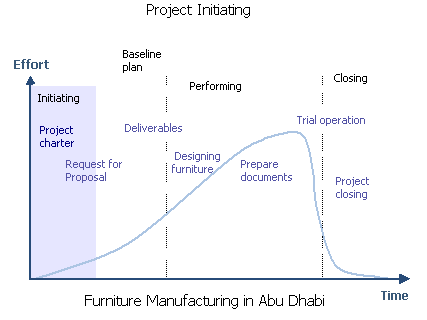
Table 1 presents the list of stages for the project development and related deliverables, along with success criteria.
Table 1. Project Stages and Deliverables
Estimated Budget
According to the estimates made by the members of the project team, the required budget is around 2,500,000.00 DHS. The details regarding the costs related to project development are provided in Appendix A. In this project, the main focus is on investing in the establishment of the furniture manufacturing company using the finances of the project team members. Therefore, it is necessary for the project developers to remain equal partners during the work on the project, and equal investments in the project are expected. The defined budget will allow the project group to complete all the activities and mitigate the possible risks that may occur during work on the project.
Project Schedule and Time Analysis for the Project
Project Milestones Schedule
In project management, milestones are used in order to determine specific tasks or points within the timeline. Using milestones, project managers determine start and end dates for certain phases of a project as well as outcomes to be achieved (Martinelli & Milosevic, 2016). The milestones identified for this project are provided in Table 2. This project started in March 2017, and the end date was set to be June 26, 2017.
Table 2. Project Milestones Schedule.
Work-Breakdown Structure (WBS)
In order to divide the project into smaller components consisting of phases and deliverables as well as milestones, it is necessary to apply a work-breakdown structure (WBS). As a result, it is possible to present the scope of work associated with each phase and deliverable with the help of a hierarchical structure (Badiru, Rusnock, & Valencia, 2018). In the context of this project, phases related to deliverables include the development of the project concept, the design of the business and quality plans, the approval process, implementation and development, operation and production, and manufacturing furniture. Tasks for each phase to address project deliverables and milestones are presented in Figure 2, and there are four levels for the WBS to emphasize the hierarchy of tasks. The WBS was created with the help of the Plan Hammer online tool for creating charts. The first stage of developing the WBS is presented in Figure 2, and Figure 3 illustrates the final version of the chart. The responsibility assignment matrix to determine the persons responsible for completing each task is added as Appendix A.
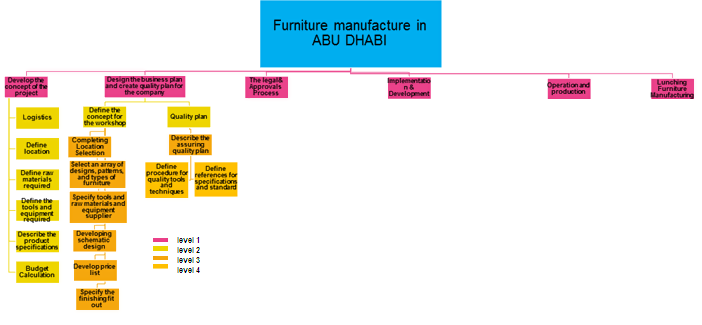
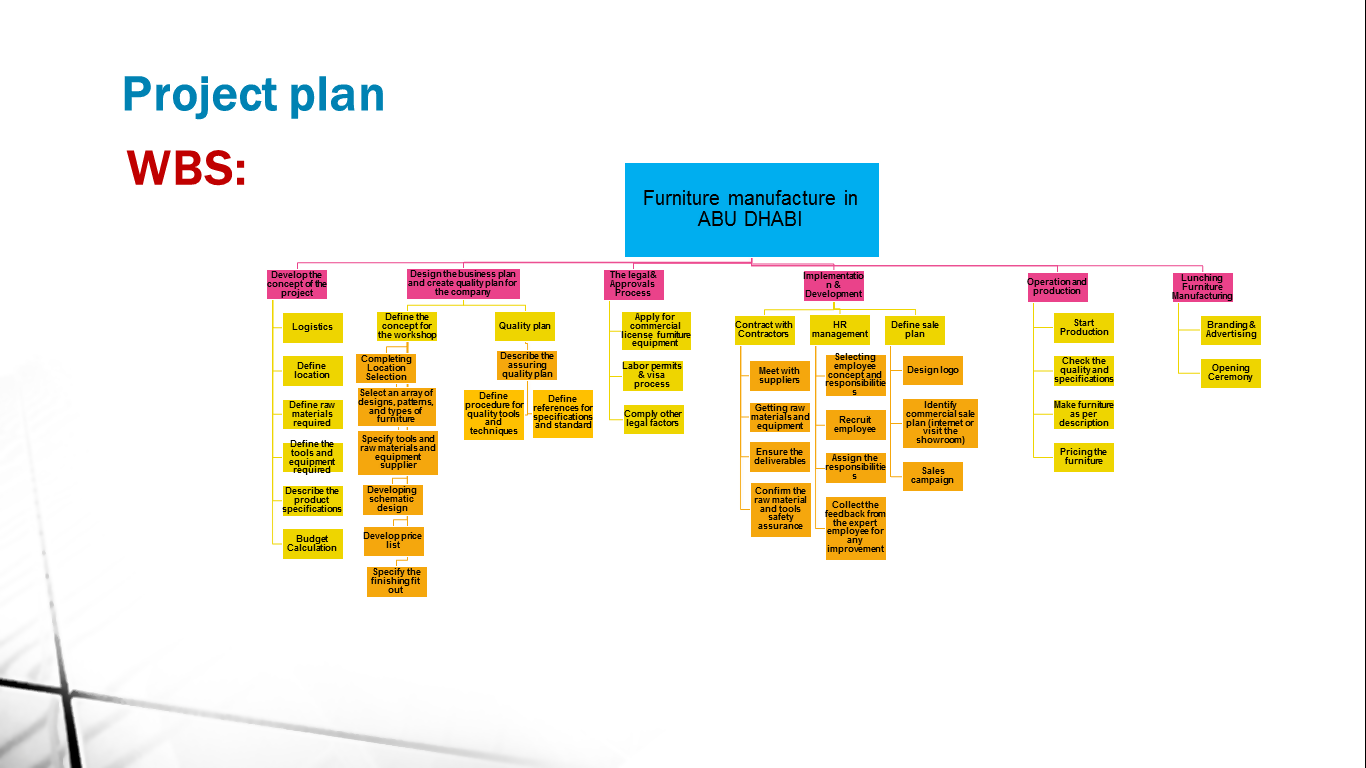
Project Schedule
Table 3 presents the list of activities that are required to achieve the project goals in relation to its major stages, deliverables, and milestones, along with the due date. These activities were previously included as stage components and deliverables in the WBS. In addition, a specific number is assigned to each activity in order to depict the process of project development schematically.
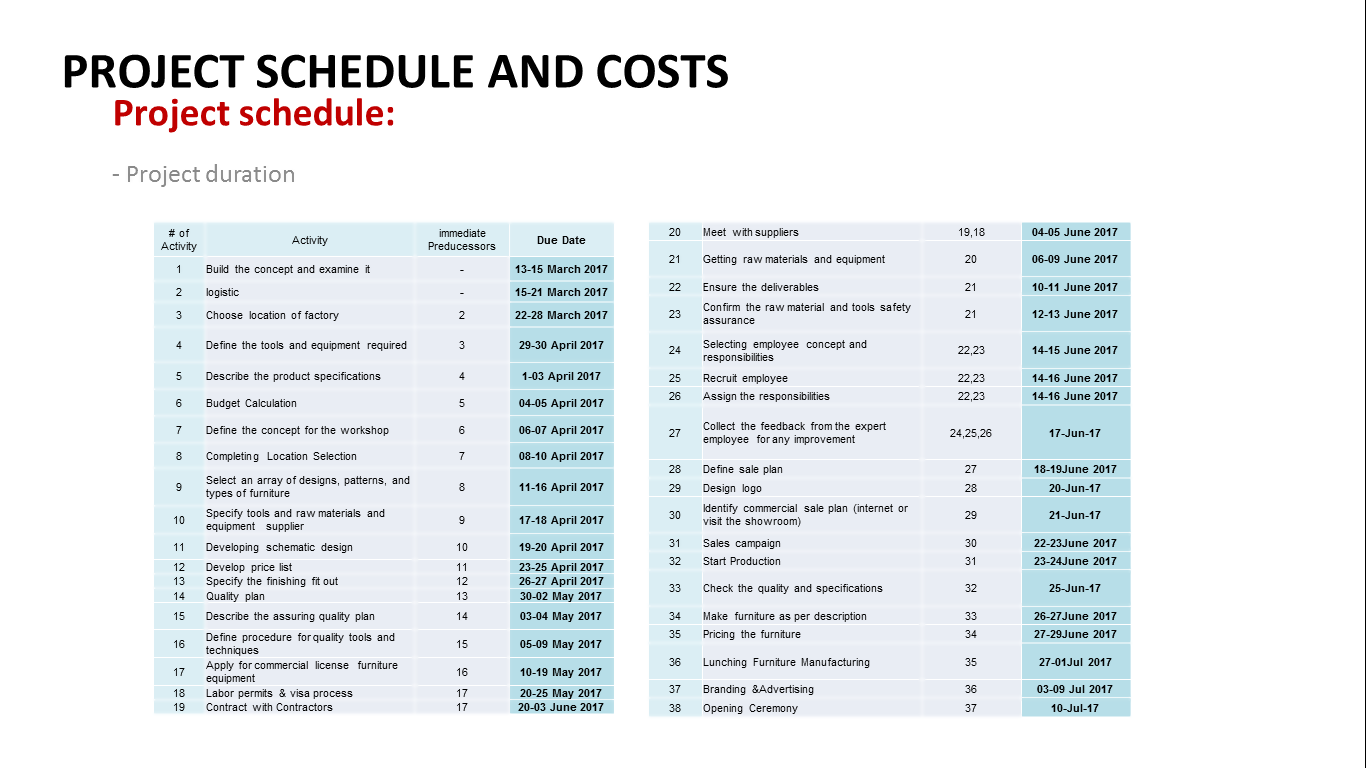
Forward and Backward Passes with Total Slack
Determining forward and backward passes, as well as slacks, is important for identifying a critical path for the project. In this context, a forward pass is associated with moving forward using a network diagram to understand where a critical path can be found. A backward pass is associated with determining when a late start would be appropriate depending on a slack. Thus, a slack in a project schedule is a period before starting another task after completing the previous one (Martinelli & Milosevic, 2016). In this project, the majority of tasks have a zero (0) slack, which characterizes these tasks as critical. According to Table 4, only two activities have a definite slack. As a result, delays in completing the majority of tasks in this project can result in an overall delay in finishing the project on schedule. Table 4 represents the duration estimated for completing the task on time and the number of days required, an early start or finish, a late start or finish for these activities, as well as the total slack.
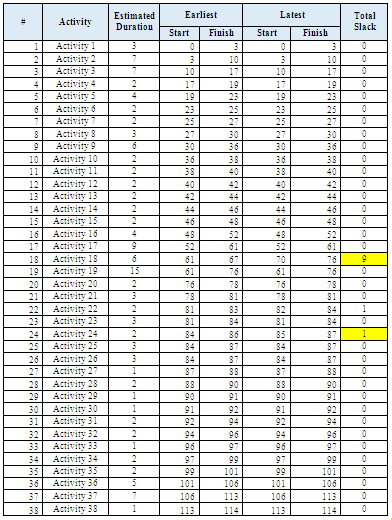
Network Diagram
All the activities that need to be completed for this project can be represented in the form of a network diagram that allows for focusing on a graphic presentation of the activities in relation to each other. Figure 4 includes a basic network diagram adopted for this project. Nodes indicate the number of the activity and its place in the network diagram (Binder, 2016). Arrows illustrate the dependencies of completed tasks on one another in the context of the project.
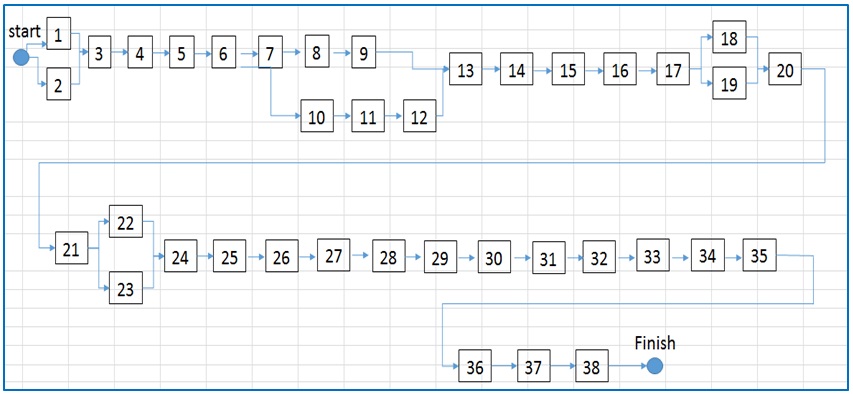
Gantt Chart for the Project
Taking into account the project milestones and the network diagram that was developed, a Gantt chart was designed for the project to represent a project schedule with a focus on the relationships between activities, the periods set for completing certain tasks, and the current status of an activity. Figure 5 illustrates the intermediate result in the development of the Gantt chart with the help of the Online Gantt Chart tool with a focus on two project milestones. Figure 6 represents the final version of the Gantt chart, where the project milestones and associated steps are identified. The critical path is highlighted in orange, and the block highlighted in green presents the activity with a certain slack. The baseline is set after achieving the second milestone for the work completed, and pink blocks indicate delayed activities. In order to effectively monitor the milestones, it is necessary to focus on completing tasks on a critical path and receiving timely and detailed reports from the persons responsible for each activity (Appendix A; Binder, 2016). The project manager should be immediately informed about the risk of a delay in completing tasks on a critical path.
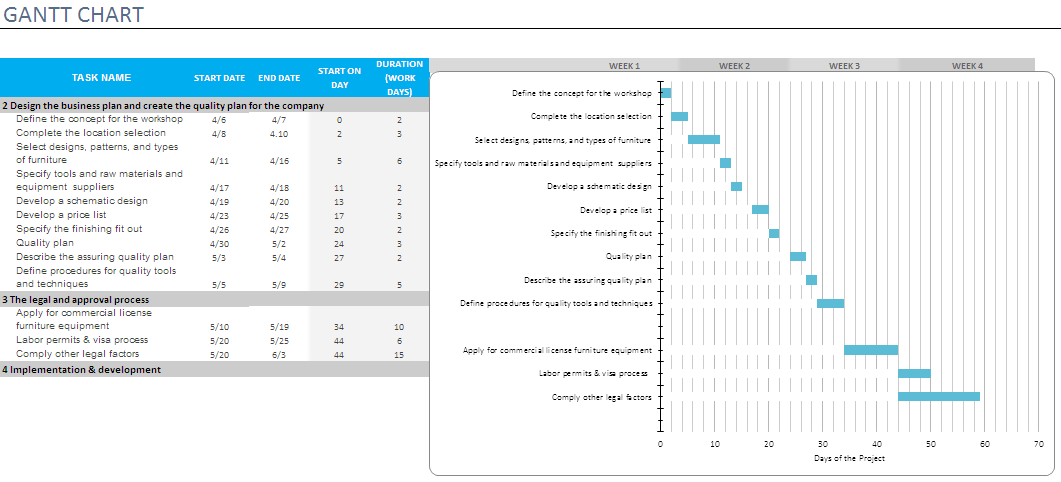
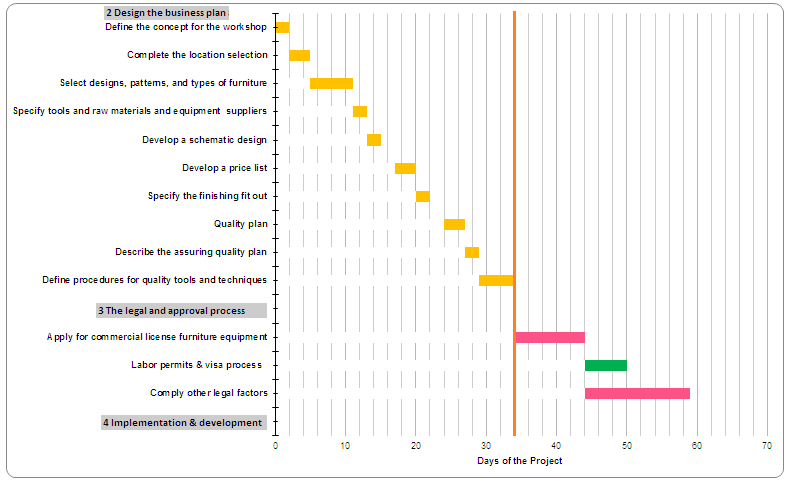
Project Network and Critical Path
The advanced version of the network diagram designed for this project identifies each activity with an assigned number (the order of activities is important), and the duration of each activity is identified by the number of days required for completing the task (Badiru et al., 2018). Figure 7 represents the advanced network diagram with a focus on dependencies between activities. Figure 8 provides a critical path for the project, with all critical activities highlighted in gray. According to the proposed network, if there are delays in any of the gray activities, it is possible to expect a delay in finishing the whole project.
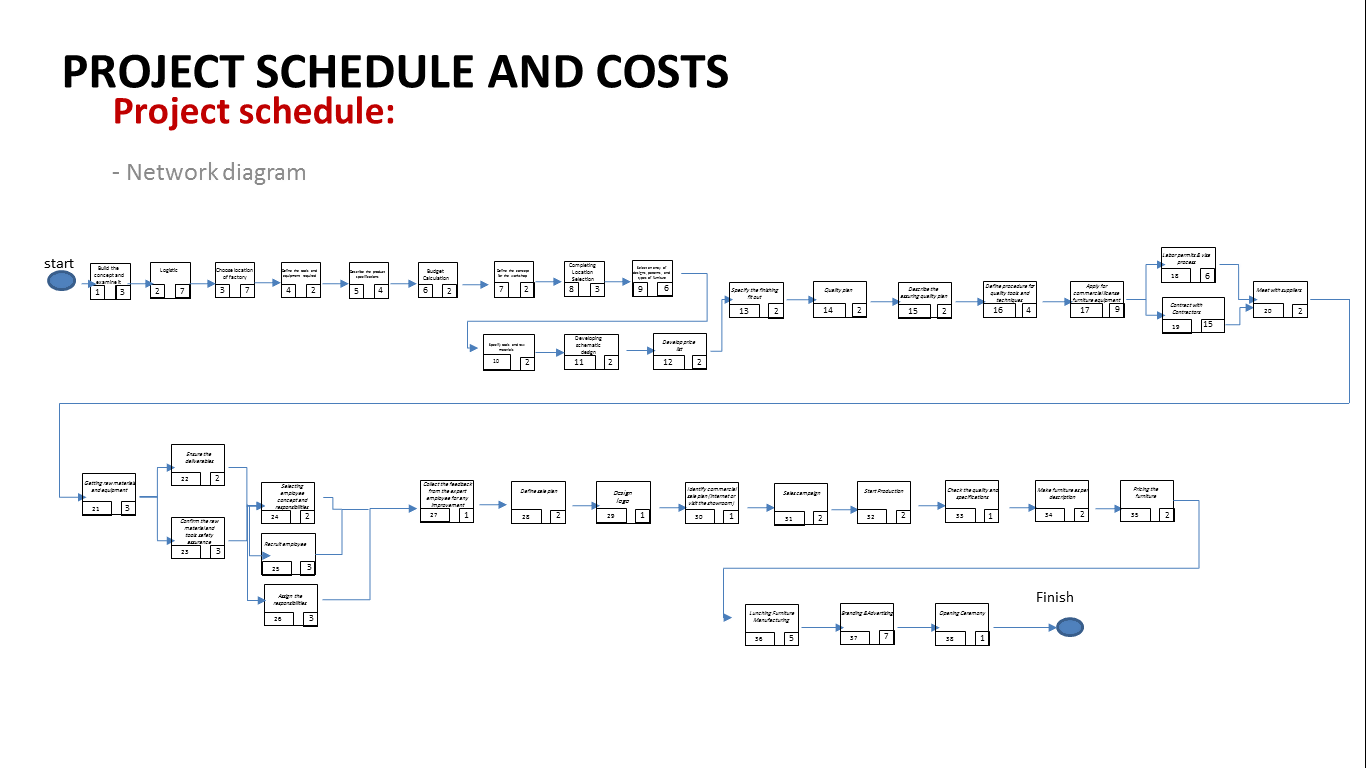
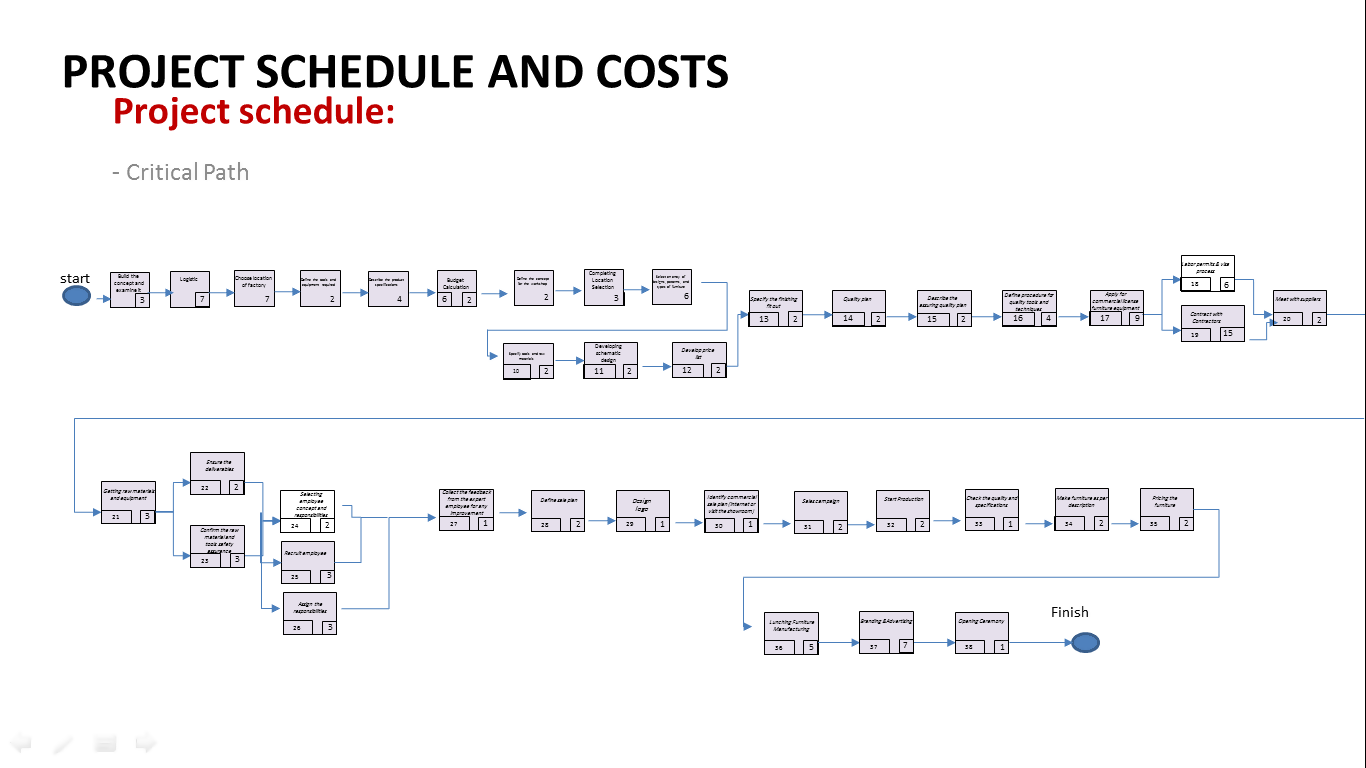
Project TimeLine and Delays
According to the project schedule, the activities associated with the first and second milestones were planned to be completed within 48-52 days. After the successful completion of these activities (40% of the project tasks were successfully finished), the project developers started the legal and regulatory approval process. The activities associated with applying for the commercial license for furniture equipment were started on time, but the process was delayed because of certain legal issues, as documents were not prepared in an accurate way. In spite of the available slack related to the next activity (receiving labor permits and visas), it was not enough to cover the delay of 32 days associated with applying for and receiving the license for equipment.
As a result, it was impossible to start the work related to getting labor permits and visas and contacting the contractors on time. The delay in the approval process made it impossible to continue project development without receiving all the required documents to make sure that the business was legal. Consequently, the activities connected with milestones 3, 4, 5, and 6 were not completed. The human factor and problems in exchanging data led to significant delays in completing the project.
Analysis of Likely Risks of Further Delays for the Project
Analysis of Likely Risks
It is possible to identify a range of risks that can cause delays for the project at present or in the future. The first category of risks includes on-site accidents, especially fire in the workshop. It could be caused by the human factor or problems with electric equipment. The likelihood of this accident is low, but its effect on the project is high because of the potential loss of resources (Martinelli & Milosevic, 2016). Table 5 represents the response plan for this risk and the required budget. Other risks include thefts from the facility, which can be prevented through improving security systems. Problems with work associated with data storage and exchange services can also lead to delays in completing orders, and the response plan is based on using antivirus software and cloud services to store information.
The non-delivery of material is another risk that directly affects the operations of the company, and it can be addressed with a focus on improving inventory management and work with suppliers. The improper functioning of the equipment because of environmental and human factors can potentially lead to delays in completing orders because of shifted deadlines or a changed schedule. Finally, a lack of orders and clients is also a risk for the company because of the impact on the company’s income and budget distribution. Steps in the response plans for all listed risks are provided in Table 5.
Table 5. Risk Response Matrix.
In this project, the delay was associated with problems in planning the project development stages to determine the appropriate time period during which certain activities could be completed. Additionally, human and external factors affected the process of applying for the commercial license for furniture equipment. The problem was in the lack of certain documents to continue the approval process and receive labor permits and required visas. There are many requirements that furniture manufacturers must comply with, and the activities of the company should be conducted in accordance with the legal standards of the United Arab Emirates. The application of ISO 14001 and ISO 18001 and obtaining the acceptance forms for the products from the Emirates Authority for Standardization and Metrology is required.
Thus, a database malfunction and problems with storing and exchanging data also led to the delay because it was impossible to prepare and use all the required documents on time. In the future, these risks and causes of delays, as well as those mentioned in Table 5, can potentially lead to such consequences as the loss of equipment, resources, and clients. It is important to revise the approach to planning the project to ensure that any set time periods are feasible and to recruit effective staff who will be responsible for working on the company’s documentation. It is important to avoid similar situations in the future by addressing all the identified risks according to the response plans.
Project Crashing and Fast Tracking Approaches
In order to address the identified delays and guarantee that the project will be completed by the scheduled date, it is possible to apply techniques for schedule compression: crashing or fast-tracking. To shorten the duration of the project, a manager can use crashing, which is based on adding more resources from external and internal sources for the purpose of completing tasks on a critical path (Martinelli & Milosevic, 2016). As a result of using other available resources for completing critical tasks, it is possible to expect that activities will be performed without delays, but the application of this technique is associated with increasing the cost of the project.
Fast-tracking is based on the idea of simultaneous completion of tasks that were initially planned to be sequential in the project network. Despite the fact that this approach can significantly reduce the project duration, there is an associated risk of completing tasks with mistakes (Badiru et al., 2018). Furthermore, this technique cannot be used for all tasks because some activities depend on each other and cannot be completed as parallel tasks (Binder, 2016). However, its benefits include avoiding the involvement of additional resources or increasing the cost of the project.
In this project, the delay can be overcome with the help of fast-tracking. This approach is most appropriate for this project because work on several tasks simultaneously will contribute to reducing the time required for achieving milestones 4, 5, and 6 in this project. Such tasks as defining a sales plan, designing a logo, identifying a commercial sales plan, and developing a sales campaign can be performed as parallel activities without decreases in the quality of the outcome. Furthermore, making furniture according to its description and pricing can also be performed during the same time period (Figure 9). The reason is that the development of a sales plan and the design of the logo do not depend on each other. Moreover, all activities related to developing a sales plan and campaign can be combined because they are performed by the same specialists. As a result, no additional resources will be required to complete the project.
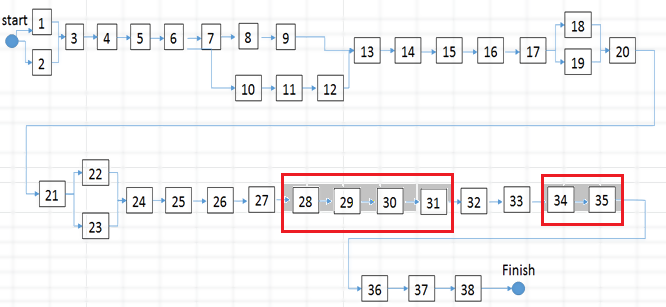
Recommendations and Conclusion
The completion of the project according to the set schedule and timeline is possible when a project manager is focused on determining a realistic and feasible duration for certain activities, minimizing the negative effects of following a critical path, and predicting potential risks. In this project, the development of the project schedule and the analysis of its feasibility was accomplished by determining the project deliverables and milestones and with the help of the WBS, network diagrams, and Gantt chart. The project delays and outcomes were analyzed with reference to risk assessment and schedule compression techniques. The following groups of risks were found to have a potential impact on project development and future furniture manufacturing activities: accidents in the facility, scheduling issues, theft, database malfunction, non-delivery of material, improper functioning of the equipment, and a lack of orders or clients. The fast-tracking technique discussed above can be viewed as an effective measure for coping with the delays experienced by this project.
The following recommendations can be proposed for improving project scheduling and time management with reference to the analysis that was conducted:
- Considerable attention should be paid to project planning and scheduling in order to set realistic durations for tasks.
- The risk management plan should be developed while starting the project.
- The budget should be determined with reference to the project realization and risk management plans.
- The focus should be on monitoring progress and reacting immediately to risky situations.
- It is important to ensure the immediate and secure exchange of data and resources between members of the project team. It is also important to organize effective communication between team members.
- The application of a variety of project development and analysis tools and software makes it possible to minimize the use of resources and structure project tasks.
- It is important to ensure the project managers have developed skills in applying the critical path method and schedule compression techniques.
Appendix A
Responsibility Assignment Matrix and Project Budget
References
Badiru, A. B., Rusnock, C. F., & Valencia, V. V. (2018). Project management for research: A guide for graduate students. New York, NY: CRC Press.
Binder, J. (2016). Global project management: Communication, collaboration and management across borders. New York, NY: Routledge.
Martinelli, R. J., & Milosevic, D. Z. (2016). Project management toolbox: Tools and techniques for the practicing project manager (2nd ed.). Hoboken, NJ: John Wiley & Sons.
UAE’s GDP to grow 3.8% on average in next 5 years: Dubai Chamber. (2019). The Gulf News. Web.